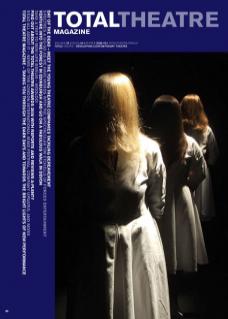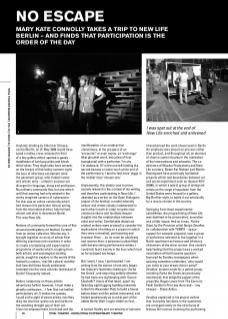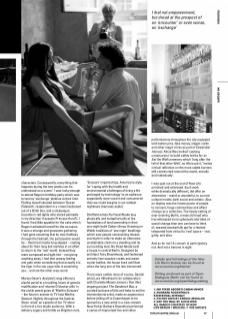Anybody strolling by Chloriner Strasse, central Berlin, on 31 May 2008 would have spied a motley crew, amassed in front of a tiny gallery which sported a gaudy installation of lurid pop pinks and kitsch tinfoil silver. They might also have sensed, on the breeze of that balmy summer night, the buzz of infectious excitement amid the pavement group, who traded names and artistic aims – united in purpose yet divergent in language, dress and profession. No ordinary community this, but one which until that evening had only existed in the murky imagined caverns of cyberspace. For this was an online community which had chosen this particular time to spring, from the international ether, fully formed, vibrant and alive in downtown Berlin. This was New Life.
Notions of community formed the core of this unusual participatory art festival. Curated from an online collective, Wooloo.org, it brought together an array of artists from differing practices and countries in order to create a tantalising and experimental programme of works which, erupting from both artistic and sociological starting points, sought to explore, in the words of the festival’s curators, ‘real life cultural mobility’. And how did these heady sentiments translate into the vivid, eclectic landscape of Berlin? Eloquently indeed…
Before I elaborate on these artistic adventures further however, I must make a ghastly confession… I fear (but not loathe) participatory art. It makes me queasy. I quail at the sight of street artists, lest they drag me into their quirky orb and make me the unwilling straight guy of their act. I feel not empowerment, but dread and the manifestation of an unattractive clamminess, at the prospect of an ‘encounter’ or even worse, an ‘exchange’ (that ghoulish word, evocative of liver transplants) with a performer. I’m shy. I’m awkward. If I’m the one left holding the sacred banana or some-such at the end of the performance, I tend to feel more ‘piggy in the middle’ than ‘chosen one.’
Unpleasantly, this phobia was to prove acutely relevant in the context of my writing and therefore participating in New Life. I attended as a writer on the Open Dialogues project of the festival; a model whereby writers and artists closely collaborated in each other’s work in order to ignite new communications and facilitate deeper insights into the relationships between artist and writer. Comfortable distances eroded, writers were pressed to consider the implications of writing on a project in which they were enmeshed, participating and invested. Hmm… so no room for aloofness and reserve then; a poisonous junket filled with banana-toting performance artists, I could tell, feel it keenly in the liver which had so far escaped exchange…
But I went, I saw, I participated. I am writing from the stance of one who began her festival’s festivities chatting to ‘Zorba the Greek’, and enquiring politely whether he had done any sightseeing with ‘Queen Elizabeth?’ (more of that later), spent my Saturday night lugging building materials to Berlin’s Alexander Platz to build a house before dawn and the polizei intervened, and fretted ponderously as to what part of the edible Berlin Wall I might nibble on first…
A certain fluidity and uncertainty of outcome characterised the work showcased in Berlin. An emphasis was placed on process rather than product, and throughout all, an element of chance came into play in the realisation of the interventions and artworks. The co-directors of Wooloo Productions and New Life curators, Sixten Kai Nielsen and Martin Rosengaard have previously facilitated projects which test boundaries between art and social experiment such as Asylum NYC (2006), in which a select group of immigrant artists on the verge of expulsion from the United States were housed in a gallery, Big Brother-style, to battle it out artistically for a visa to remain in the country.
Springing from these experimental sensibilities, the programming of New Life was destined to be provocative, evocative and a little risqué. And so it was. Fictive Days, by the Peruvian artist Sergio Zevallos (in collaboration with TEMPS – space support for nomadic projects), saw a group of performers selected to live together in a Berlin apartment as famous and infamous characters of the silver screen. One couldn’t help feeling that this project was a wicked incarnation of that tiresome question favoured by Sunday newspapers when quizzing sometime celebrities; ‘who would you invite to your dream dinner party?’ Zevallos’ answer made for a potent group, including Zorba the Greek (as previously mentioned), that delightful poppet of the projectile, Regan Lewis from The Exorcist, Flash Gordon’s Princess Aura and – ‘say cheese’ – Diane Arbus.
Zevallos explained in his project outline that ‘everyday functions in the apartment are arranged solely on the structures of famous film scenes involving the performing characters. Consequently, everything that happens during the two weeks can be understood as a scene’. I was lucky enough to attend Regan’s birthday party which was to test my ‘exchange’ phobias to their limit. Finding myself situated between ‘Queen Elizabeth’, resplendent in a crown fashioned out of a Brillo box, and a statuesque brunette in red tights who stared pointedly in my direction (I assume Princess Aura?), I found I had little appetite for the cake which Regan had baked herself for the occasion. It was a strange and gruesome gathering. I had gone assuming that by now (halfway through the festival), the participants would be – theatrical masks long slipped – casting about for their long lost marbles in an effort to return to the ‘real’ world. Instead they were composed and tight knit – not giving anything away. I had that uneasy feeling one gets when considering that actually it is the tiger in the zoo cage who is examining you…and not the other way round.
Marisa Olson’s Assisted Living offered a playful portal to a troubling future of genetic modification and ‘vitamin D blocker pills’ in the sickly sweet guise of ‘Martha Scissors’ – the future’s answer to TV host Martha Stewart. Nightly throughout the festival, Olson ‘aired’ an episode of her TV show in front of a live studio audience. With a delivery sugary and brittle as Brighton rock, ‘Scissors’ imparted tips, Americana style, for ‘coping with the health and environmental challenges of living a life prolonged by technology’ to an audience supposedly more vacant and consumerist than we could imagine in our wildest nightmare (bananas aside).
Sheffield artists No Fixed Abode dug physically and metaphorically at the foundations of land ownership in their one-night build Caban Unnos. Drawing on Welsh traditions of ‘one night’ dwellings which saw people constructing houses overnight in order to stake an otherwise unattainable claim on a dwelling and its surrounding land, No Fixed Abode built a house in central Berlin. Designed by architect Tony Broomhead, and fashioned entirely from wooden crates and water cooler bottles, the house lived until 6am when the long arm of the law intervened.
There were oodles more of course; Danish artist Lars Vilhelmsen’s (in collaboration with Charlotte Mosen Jensen / Den lille) ongoing project The Sandwich Box, a curated suitcase of bits and bobs to aid the interventionist artist, made an appearance before jetting off to Copenhagen to be opened by a new artist in a new context. New Yorker Barbara Rosenthal performed a series of improvised live and video performances throughout the city equipped with button pins, fake money, slogan cards and other magic tricks as part of Existential Interact. Alicia Ríos invited ‘cooking constructors’ to build edible brinks for an Eat the Wall ceremony which ‘long after the fall of that other Wall’, as Alicia put it, ‘invites critical reflection on the more subtle barriers still constructed around the world, socially and individually’.
I was spat out at the end of New Life enriched and enlivened. Each work while dramatically different, did offer an alternative – weird or wonderful, to current cultural modes, both social and artistic. Also on display was the innate power of people to connect, forge communities and affect change as a collective. The heady setting of ever-evolving Berlin, a wise old head who has witnessed more upheavals and tides of social change than one can bear to think of, seemed wonderfully apt for a festival teleported from virtual to ‘real’ space – real, gritty, and alive.
And as for me? A convert. A participatory nut. And not a banana in sight.
Details and full listings of the New Life Berlin festival can be found at www.wooloo.org/festival
Writing produced as part of Open Dialogues Berlin can be found at www.wooloo.org/opendialoguesblog


